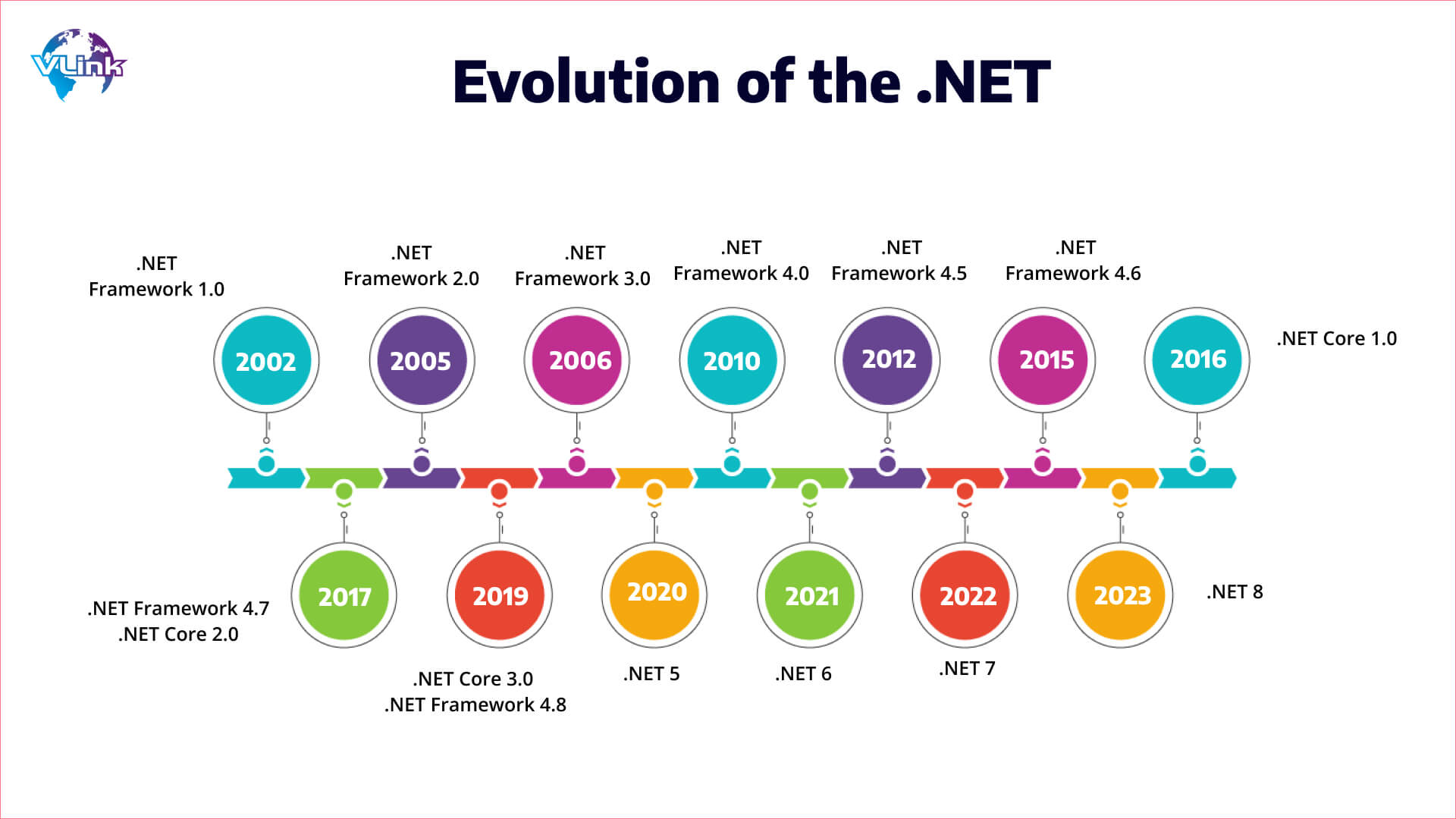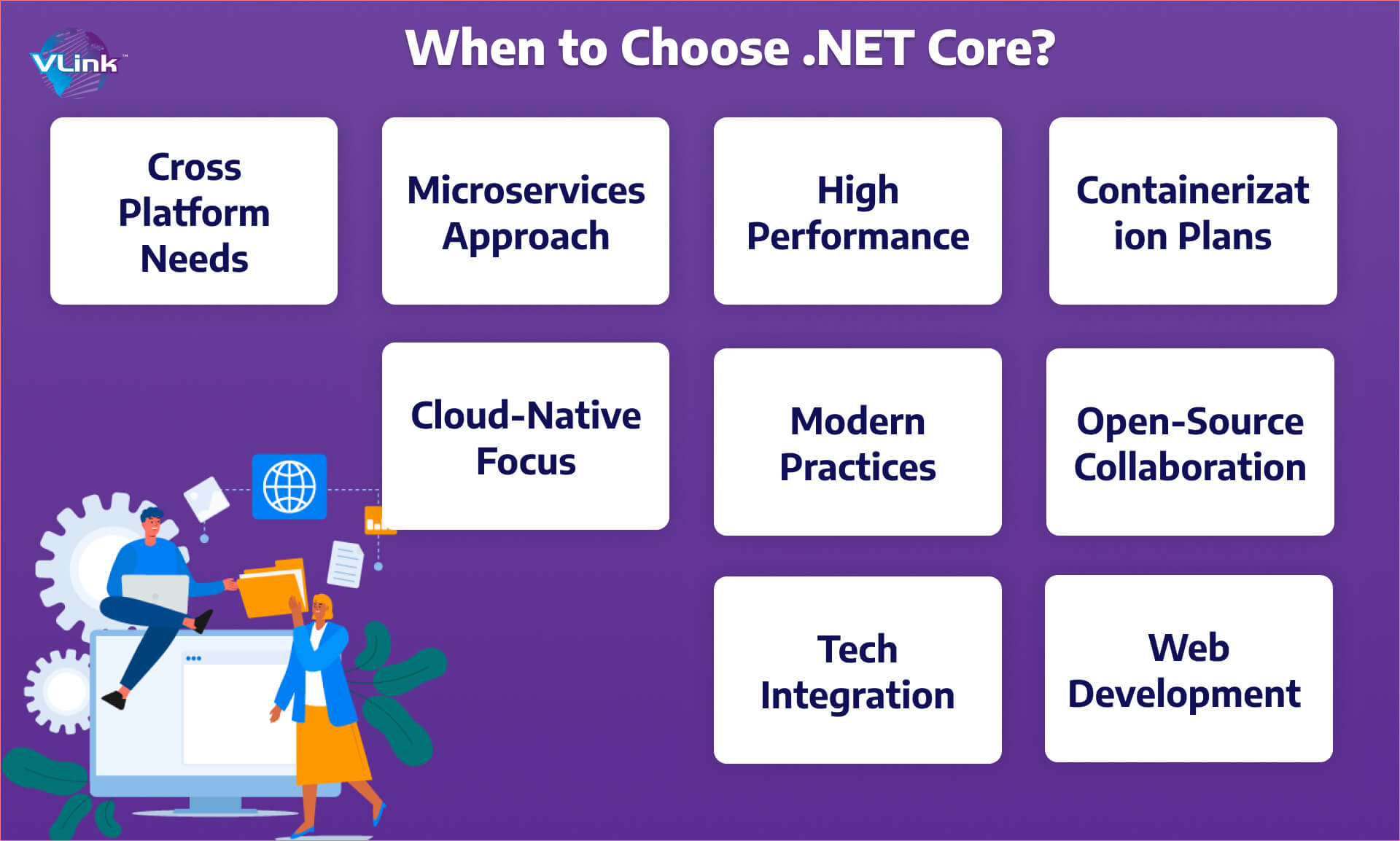There are many terms ruling the software industry today— dot NET framework, .NET Core and .NET which are all almost the same but used for different purposes, so one should know which to use. The journey that started back in 2002 with the establishment of the .NET framework has seen many transformations in the last two decades.
One such transformation happened with the release of a cross-platform re-build of .NET framework—dot NET core back in 2016. But the question here is—why did Microsoft come up with this release and how has it helped and changed over the years?
Let us dive in and find answers to all these questions together!
The Evolution of the .NET

In the late 1990s, Microsoft got down to business with the .NET framework. The novel idea back then was to establish a platform based on what was called “managed code”—a code that can be run in a runtime environment.
It became a necessity with a view to streamlining the development background and enabling engineers to avoid worrying about security checks, active memory assembly, and other low-level measures that C/C++ software engineers had to undertake.
- The .NET Framework Era
In 2002, the first .NET Framework was launched, which included C# – a language for writing managed code, whose syntax was similar to C++. The framework was aimed for computers and servers running on Windows.
It contained WinForms—a graphical user interface library, ASP.NET – a web framework, and ADO.NET for access to data, which were driven by Common Language Runtime or CLR for compiling and executing managed code.
- The .NET Core Era
In 2014, Microsoft made a loud statement that .NET was changed quite drastically – .NET Core was developed, a cross-platform, cloud-friendly and open-source version of the framework. In the year 2016, .NET Core went out of release, and it became the top technology to choose for further .NET projects. Little by little, Microsoft started to port the existing services to interact with Core.
Why is .NET Core Open Source?
Now that you know what is .NET core, let us now discuss the reasons why Microsoft released dot NET Core open source.
While talking to Wired in 2016, Julia Liuson, corporate vice president of Miscrosoft’s developer division, said, “the way to reach developers was through open source. So Liuson and company endeavored to make .NET more open than ever before, and that meant making it run not just on Windows, but wherever developers might want to use it.”
In simpler terms, Microsoft made dot NET open source to ensure that it was adopted and used in more systems. Open sourcing Dot NET made Microsoft relevant to developers, and the company’s influence expanded beyond the Windows systems.
Plus, open sourcing allowed for cross-platform development. As a result, .NET can now be run on non-Windows systems such as Linux and MacOS.
Difference Between .NET Framework and .NET Core Framework
There are commonly two confusions—one is the difference between .NET and ASP.NET and the other is difference between .NET framework and .NET Core Framework.
Here, we will tell you how .NET framework is different from .NET Core framework:
- Open Source
The entire Dot NET Core platform is open source and is released under MIT as well as Apache 2 licenses. On the other hand, only specific components of the dot NET Framework are open source.
- Cross Platform Support
The other difference is that .NET Core runs on Windows, macOS, and Linux while .NET Framework only supports Windows.
- Architecture
Considering its streamlined design, some subsystems such as code access security in the .NET framework are not implemented in dot NET Core.
- API Support
Some parts of APIs (Application Programming Interface) in the decades-spanning dot NET Framework have not been ported over into the newer cross-platform dot NET Core. The API set will continue expanding with future .NET Core updates.
So, .NET Core is a flexible, open-source framework for modern applications that works for all needs across environments. The .NET Framework only works for Windows. It also has a lot bigger API surface area. Needless to say, both of these frameworks have distinct significance in the software industry.
Key Characteristics of Dot NET Core

Isn't the history of .NET core interesting? Did you fall for it already? If not, here are some amazing characteristics/features of .NET core that will definitely convince you:
- Free & Open Source
The whole .NET Core platform is free and open-source which creates a huge platform for expert developers to craft futuristic enterprise-grade applications. This is the reason a large number of active developers are working in .NET Core for development and to enhance the existing features with additional functions and bug fixes.
- Modern
The dot NET Core framework is developed to address and meet the modern requirements of today’s fast-paced and rapidly changing generation, unlike most of the older frameworks and functionalities. Some modern needs include being mobile-friendly, secure, responsive, scalable, and high performance.
- Cross-Platform
The framework supports Windows, macOS, and Linux OSes. It is also remarkably consistent across architecture including x64, x86, and ARM. You can import and utilize the assemblies and libraries on substantial platforms.
.NET Core supports present-day language constructs utilizing C# version 8, inclusive of object-oriented and modular programming, generics, collections, lambdas, Language Integrated Query, and asynchronous programming.
- Faster
When compared to the .NET Framework as well as .NET Core 2.2 and previous versions, the latest ASP.NET version is superiorly fast. The ASP.NET Core 6.0 new features and upgrades are faster and reliable like no other framework.
- Lightweight & Friendly
The framework is very lightweight, as it can be included in your app or installed side-by-side user, machine-wide, or on a server. You can deploy .NET Core in Docker containers. The .NET Core framework is also compatible with .NET Framework, Xamarin, and Mono, through Dot NET Standard.
What is .NET Core Used For?

Here are some applications you can build with dot NET Core:
- Web Applications
The core part of dot NET Core diaspora is ASP.NET Core: a framework good for building web pages.
For the uninitiated, ASP.NET Core comes from the lineage of MVC architecture and provides common libraries to build the Web.
- Mobile Applications
The Xamarin presents a series of tools and libraries to make C#-based mobile apps. This facilitates and helps developers to build native apps, such as iOS, Android, Windows, and macOS. They make these apps on a common .NET codebase that is more transparent and smoother.
- Desktop Applications
With .NET Core, you get a bunch of tools and frameworks to build desktop apps. To develop desktop applications, there are four major pillars namely Windows Forms, WPF, UWP, and Xamarin. One of the best examples of desktop applications using .NET Core is Visual Studio Code. It is a code editor software which used by professional developers.
- Cloud Applications
With clouds ruling over the IT industry, the demand for cloud applications has been more than ever before. Need to mention, Azure offers support for a variety of cloud applications and Netflix is the biggest example of it.
- Internet of Things
IoT (Internet of Things) plays a vital role in mobile app development. With dot NET Core support, you can develop IoT through the UWP framework for IoT devices running Windows 10 IoT Core.
- Games
C# and UWP are utilized to build various games for TV, AR, VR, Web, mobile, console, and desktop. C# and dot NET are dynamic duo for modern web apps and games.
When to Choose .NET Core?

Here are some situations when you should be choosing .NET Core:
- Cross Platform Needs
If you wish to have your application on different systems, .NET Core is the platform you should be considering. As already mentioned earlier, it runs on Windows, Linux, Android, iOS, and MacOS.
- Microservices Approach
.NET Core is the right solution for independent microservices development as it is lightweight and has a modular structure.
- High Performance
.NET Core can be used to build applications like Web APIs, microservices, and servers—thanks to its improved efficiency.
- Containerization Plans
If you are planning to utilize Docker or any such tech, let us tell you that .NET Core is designed for simplified container deployment as well as scaling.
- Cloud-Native Focus
Dot NET Core is also exceptionally perfect for cloud-native app development. It smoothly integrates with various platforms including Microsoft Azure. All you need is to hire developers who are expert in building native applications.
- Modern Practices
.NET Core is modern, and it supports the latest features and aligns with all new development tools and technologies.
- Open-Source Collaboration
If you prioritize open source, you should try .NET Core as it facilitates community contributions and collaborations.
- Tech Integration
With the help of several libraries and frameworks, dot NET Core supports technologies such as AI (Artificial Intelligence), machine learning, or IoT.
- Web Development
.NET Core is just fit for modern and scalable web apps. Without a doubt, it is the top choice for web development.
What is the Current State of .NET Core Open Source?
Even today, .NET Core continues to be an open-source framework. In November 2020, .NET Core merged with Mono, Xamarin, and Unity, collectively becoming the “.NET 5” framework and unifying the entire ecosystem.
This merger was intended to simplify development and increase the compatibility of solutions between platforms. More recently, .NET 6, which was released in November 2021, was another milestone that added long-term support and improved performance, APIs, and tools.
The .NET Foundation governs the open-source community and promotes the spirit of cooperation and creativity. The shift towards .NET 6 confirms a commitment to modernization and transparency.
Plus, initiatives such as Project Tye and MAUI enable and simplify the work on development and deployment.
In a word, .NET Core’s transformation into .NET 6 and the integration with open-source communities reflect a dynamic ecosystem that guarantees constant development and innovation.
Hire Dot NET Developers with VLink
Want to level up your software development projects with the top 3% .NET developers?
Look no further than VLink!
We have a team of skilled Dot NET developers who deliver superior software that meets your specific requirements. With VLink, you can hire Dot NET developers in just 48 hours (about 2 days).
Be it custom web applications, enterprise solutions, or software maintenance, our Dot NET developers are always on top of their game to leave you satisfied.
Join hands with VLink and let us walk you through an outstanding Dot NET development experience.
Frequently Asked Questions
Server applications running on Mac, Windows, or Linux. Currently, it does not help for making desktop applications with the support of the user interface. When developers make an application or library in any of the .NET programming languages such as C#, F#, or VB.NET, then .NET Core helps to run such applications at any runtime.
.NET Core is a new open-source framework used for application building in various operating systems such as Mac, Windows, or Linux. It is faster in terms of performance and execution than .NET. Also, it is a scalable system and a high-performance system without the UI.
While the ASP.NET Core runtime offers vital services to internet-connected apps, including IoT apps, web apps, mobile backend, and more. On the other hand, the desktop runtime offers services to the Windows desktop apps including WPF and Windows Forms.








